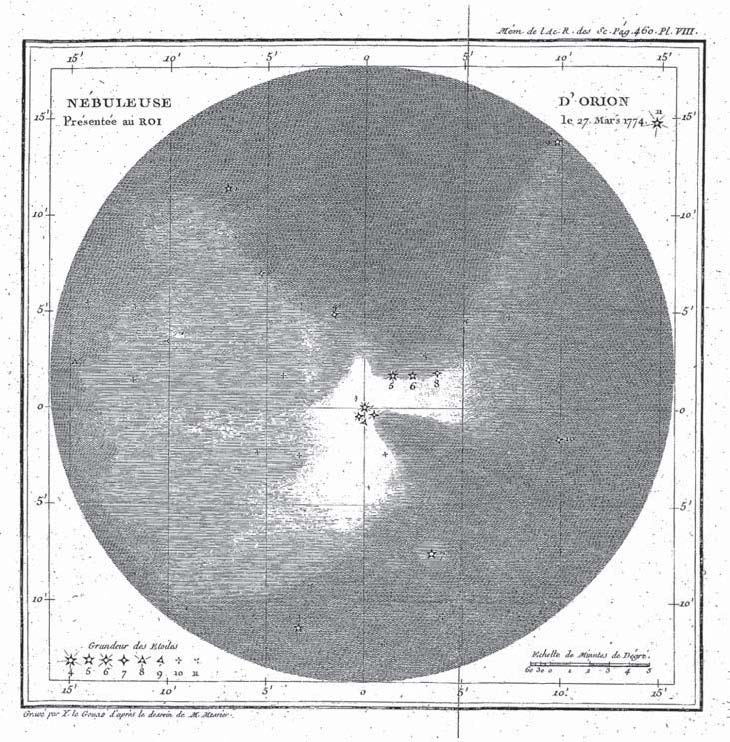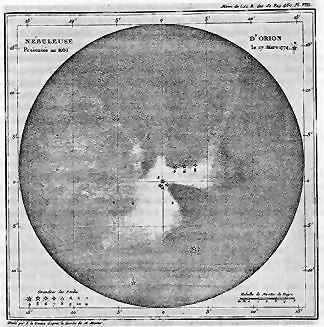Talk:Orion Nebula/Archive 1
| This is an archive of past discussions about Orion Nebula. Do not edit the contents of this page. If you wish to start a new discussion or revive an old one, please do so on the current talk page. |
| Archive 1 |
Notes
The Orion Nebula is easily visible with the naked eye as the middle star in Orion's "sword". Located at a distance of about 1,600 (or perhaps 1,500) light years, the Orion Nebula is the brightest diffuse nebula in the sky, visible to the naked eye, and rewarding in telescopes of every size, from the smallest glasses to the greatest Earth-bound observatories and the Hubble Space Telescope It is the main part of a much larger cloud of gas and dust which extends over 10 degrees well over half the constellation Orion. The linear extend of this giant cloud is well several hundreds of light years. It can be visualized by long exposure photos (see e.g. Burnham) and contains, besides the Orion nebula near its center, the following objects, often famous on their own: Barnard's Loop, the Horsehead Nebula region (also containing NGC 2024 = Orion B), and the reflection nebulae around M78. Already impressive in deep visible light photographs, the Orion Cloud is particularly gorgeous in the infrared light. The gaseous nature of the Orion Nebula was revealed in 1865 with the help of spectroscopy by William Huggins. In September 1880, M42 was the first nebula to be successfully photographed, by Henry Draper.
- The above text is a copy-paste from [1], it should not be added to the article verbatim. --Yannick Gingras 18:52, 5 November 2005 (UTC)
- I expanded the article and added in the relavent details into the article as needed. If anyone thinks something's wrong feel free to edit, of course. Andromeda321 00:08, 27 November 2005 (UTC)
Age
If anybody could find the approximate age of the nebula, I think it would greatly contribute to the article-thanks --70.161.224.44 04:01, 1 March 2006 (UTC)
- I added in some age ranges. I hope that helps. — RJH 23:32, 29 March 2006 (UTC)
Size
A quick Google search revealed that no two sources agree on the size of the Orion Nebula, which makes sense because there would be a certain amount of arbitraryness in determining where a gas cloud ends. As a result I think there should be a reference to where the current size estimate is from, so does anyone know the origin of the current size listed? Andromeda321 04:33, 31 March 2006 (UTC)
- I put in a reference. — RJH 22:12, 4 April 2006 (UTC)
Nebula Type
I made an edit that I'm not entirely sure about, but at least it has a source. What kind of nebula is the Orion Nebula? It is cited as a good example of both a reflection nebula and an emission nebula but is referred to in [2] as a "Diffuse Nebula", which includes the other two types, and the Horsehead Nebula, which is a dark nebula, is also included in Orion. Is there any consensus? I think the nebular pages need changing, this one's probably OK. --Keflavich 21:37, 5 April 2006 (UTC)
It is both a refection nebula (due to light reflection from stars behind it) and an emission nebula (due to extensive emission of ionized hyrdogen). I have never heard it called a diffuse nebula, but it could be that as well.--Metalhead94 (talk) 22:52, 31 August 2008 (UTC)
Please State Your Preference
I did some enhancing of the photograph of the Messier drawing on Photoshop, please tell me if you like one of them better than the one now in the article, or prefer the original jpg. The first one is (number 1) on the left, the enchanced photos (nos. 2 and 3} on the right and below.



I obviously like the enhanced ones a lot better -- I went to the trouble of working with it because I thought the original needed help.
- Wow that's so awesome, thanks for doing it! Personally I'm a fan of #3. Andromeda321 02:13, 6 April 2006 (UTC)
- Perhaps it's my IE browser, but it looks like the first image has the least number of defects. The other two images look noisy. — RJH 18:29, 1 May 2006 (UTC)
- I prefer the original too. Perhaps what is needed is a rescan of the original source instead of trying to fix a poor scan. WilliamKF 17:24, 27 October 2006 (UTC)
Reference source
The following reference was added to the text in reference to propylds close to the Trapezium group, but I was unable to confirm that any such publication or e-mail exists:
<ref name="Odell2006">{{cite email | author = C. Robert O'Dell | title = Orion Nebula and Mayan Civilization | senddate = 2006-10-19 | email = 'The only egregious error is the last sentence in the Stellar Formation section. It should actually read "Even though most planetary disks can form planets, observations show that intense stellar radiation should have destroyed any proplyds that formed near the Trapezium group, if the group is as old as the low mass stas in the cluster. Since proplyds are found very close to the Trapezium group, it can be argued that those stars are much younger than the rest of the cluster members.' }}</ref>
- This was an email I received directly from Dr. Robert O'Dell who is an expert on the Orion Nebula and cited throughout the article for his various papers and books. Upon my request, he reviewed the article and found one serious error which he emailed me the correction. I would say keep the correction unless you can find a source to discredit its veracity. I can forward you the email if you give me yours. You could contact Dr. O'Dell to confirm the information too, although, I imagine he would be annoyed that his email was not sufficient. I am going to put back the correction unless a source is put forth showing it to be erroneous. WilliamKF 17:20, 27 October 2006 (UTC)
- I'm not sure whether an unpublished source of this nature is suitable for such reference purposes. Not to question anybody's credibility, of course. — RJH (talk) 19:01, 27 October 2006 (UTC)
- I ended up cloning reference #13, which looks like it covers some of the same arguments. Thanks. — RJH (talk) 19:48, 27 October 2006 (UTC)
Calculating size
As far as I know you should use tangent instead of sine in: 1,500 × sin( 66′ / 2 ) = 14-15 ly. Distance from Earth to object's center is adjacent not hypotenuse in this triangle.
- True. In this case the issue is inconsequential since sine and tangent are essentially identical for very small angles. But it should probably be updated for accuracy. — RJH (talk) 17:47, 30 November 2006 (UTC)
Second thing is that apparent dimensions of nebula are 60x65 arcmins.
Winiar 16:53, 11 November 2006 (UTC)
- Do you have a source on the apparent dimensions?[3] Right now it's based on the Revised NGC and IC Catalog, per the reference. — RJH (talk) 17:47, 30 November 2006 (UTC)
orion nebula
This was very interesting I liked the pictures.
Most intense?
"Mention that although Orion is the most intense star-forming region known in our galaxy, if the Tarantula Nebula was where Orion is it would fill the constellation of Orion and be about as bright as the full moon." This from the to-do list... whoever wrote that, are you sure? I was under the impression that Orion was simply the closest intense star forming region, but the Carina Nebula and Westerlund 1, for example, are much larger star formation regions. --Keflavich 03:55, 3 May 2007 (UTC)
- I didn't write it, but it appears to be correct. The Tarantula Nebula is slightly smaller in apparent dimensions, but it looks to be 100 times more distant. That would make it pretty humongous. — RJH (talk) 16:20, 3 May 2007 (UTC)
Distance
Found this article about modern research indicating the nebula is closer to Earth than first thought [4]. Distance is given as 1300 light years. T@nn 12:46, 21 June 2007 (UTC)
- That's interesting. It's just over one σ outside the previous estimate, so it's not abnormally far off. — RJH (talk) 14:56, 21 June 2007 (UTC)
Is this the same nebula that was shown in The Fountain?
Well, is it?—Preceding unsigned comment added by 71.58.245.168 (talk • contribs)
- It appears that it may be:
- But your brusk supposition is trivia and does not belong in this article. — RJH (talk) 20:56, 4 September 2007 (UTC)
Xibalba
I wonder how accurate the claim is that the Orion Nebula is what Mayan thought was their underworld, Xibalba. I question this for three reasons: 1) I am an amateur astronomer and have never heard this before. Of course I can't know everything, but my eyebrows were raised when I watched the film The Fountain which made the claim that the Orion Nebula was in fact related to this Mayan underworld. 2) When I looked up the reference in the this article that supported the claim that the nebula was connected to Xibalba, it was an interview [5] with the director of The Fountain. I'm not sure this is a very credible source on its own. 3) The article on Xibalba claims that it is a dark portion of the milky way which in fact is what the Mayans referred to as their underworld, Xibalba. This makes much more sense to me, and the reference in the Xibalba article [6] seem much more credible.
I will take some time in the upcoming weeks to do fairly scholarly search on this subject, and will post my findings. In the meantime if anyone has anything to add about this part of the article, please add it to the discussion here. --Cheule 03:22, 4 September 2007 (UTC)
As I promised, I've been doing some research on this. I was lucky enough to converse with the current Director of Giffith Observatory, E. C. Krupp, via email on the matter. In his email he expressed that the Orion Nebula was not seen as Xibalba by the Maya and that as mentioned the Xibalba article, the dark rift in the Milky Way was seen as the entrance to Xibalba but not Xibalba itself. He is mailing me a photocopy of his article, which I expect will put this issue to bed. If not, he has directed me to a scholarly work on the topic called Maya Cosmos by the late Linda Schele and David Freidel. When I have one of these more authoratative sources in hand I will edit the article accordingly. --Cheule 04:45, 21 September 2007 (UTC)
Does no one else see this?
Let me start by saying astronomy, not my thing, but I am now obsessed with the Orion Nebula. Why? It is way too clear to ignore that there is a baby, or fetus or whatever...this nebula is like the essense of all creation its insane... —Preceding unsigned comment added by 209.183.34.44 (talk) 14:11, 7 November 2008 (UTC)
